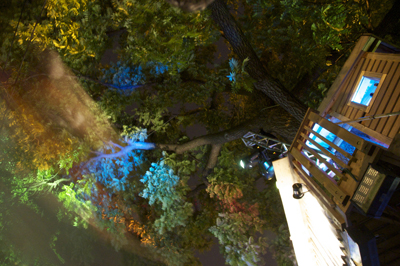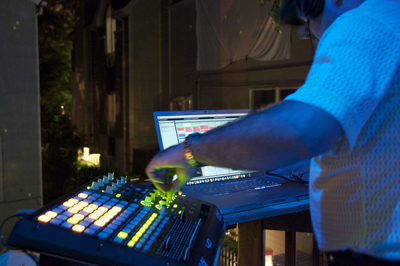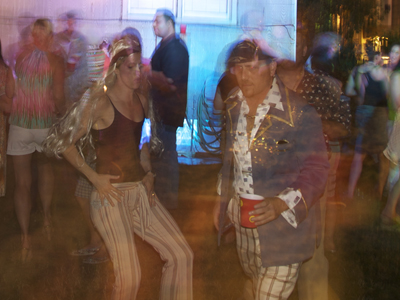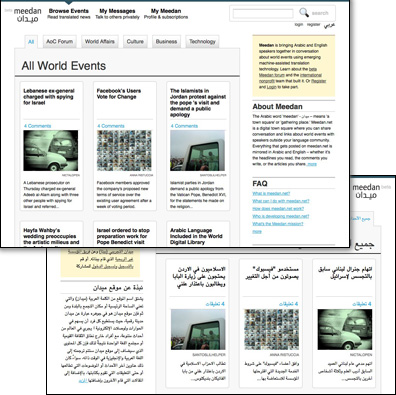“The Rock” Irish Red Ale
Last year, on Sept. 29, my wife’s grandfather William Burke, the center of her family, passed away. Rocky, as he was known to family and friends, was a larger-than-life gentleman who would enter a room and, on the rare occasions when he didn’t know everyone, would make a point of befriending every last person during the course of their encounter. Rocky was a supernode in the world of social networks before we thought of them as such — and he went out of his way to make sure people’s lives were better for knowing him.
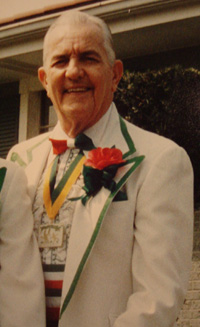
Rocky also enjoyed a good libation, several in fact. Growing up in the Irish Channel in New Orleans, Rocky came from a culture surrounded by alcohol. And, while he demonstrated an understanding of the responsibility drinking entailed, he never let that get in the way of heartily embracing the bonhomie it produced. Rocky wasn’t a stranger to anyone and he wasn’t a stranger to beer.
This is why I recently decided to turn my wine- and cider-making apparatus and technique towards the goal of creating a brew in honor of Rocky.
In hindsight it almost seems preordained. Had to make an Irish Red Ale, of course. But it was anything but orderly. Making beer, while on paper simpler than making wine, is different in important ways — most notably, the use of more separate ingredients and high heat.
I’d had the components for months but they went unused until my old Atlanta pal Patrick Childress found himself in Chicago on a work assignment. Patrick is a beer-schooled brewmaster and his tutelage was absolutely essential to the undertaking. My family and I spent a fantastic summer Saturday with Patrick as he stepped us through the finer points of beer-making with the deep knowledge and quick wit of a Food Network host.
Here’s a video of the day’s activities, wonderfully narrated by the brewmaster.
It turned out great, far better than expected and, I’ll admit, better than the wines we’ve made in the past. Helps to have a board-certified brewer in the mix.
If you’ve never had an Irish Red Ale I’d recommend O’Hara’s Irish Red or Great Lakes Conway’s Irish Red. (You get a sense of what it should be from Killian’s, but as the Sam’s Liquors beer ubergeek told me, that really isn’t what it should taste like.) Or, get yourself over to my place and we’ll crack The Rock.

The label was particularly fun to make, if not an example of exceptional illustration skills. Every year for the New Orleans St. Joseph’s Day parade Rocky would don an red and green tuxedo and march with Italians (and Irish), celebrating his neighborhood and their traditions. We have many photos of him in a variety of Leprechaunish garb — all of which capture in a small way the man’s love for fun and embrace of the moment.
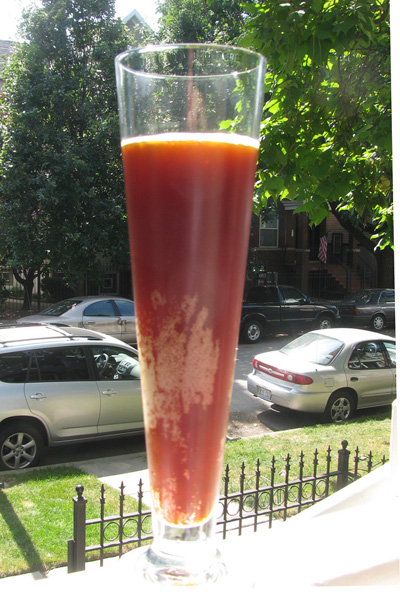
So here’s to you, Rocky. A tip of the hat, a clink of the glasses. Sláinte! Thanks for many wonderful years.
Full photoset here.
The cost of my current
This will shock no one given my lifestyle data obsession and current work focus, but I am now monitoring our home energy usage (and cost) in real time.
Back in April I noted in a harmless tweet what seemed to be far more attention to home power monitoring solutions in the UK than in the US. This prompted my excellent colleagues at IBM Hursley to try to help me out. The geeks at Hursley had for a while been playing around with the data outputs of monitoring hardware made by Current Cost. They saw my tweet, knew that Current Cost had modified some of their gizmos for US usage, and arranged to send me one.
I have bad luck with electrical home projects and I feared this one quite a lot given that I’d have to fuss with the house mains, but the installation proved remarkably easy. True, there are (as yet) no US-specific FAQs or video tutorials, but the idea was straightforward: find the mains and put the clamps over them.
In most of the UK this means locating the circuit breaker/meter combo which is located outside the house. In the US, only the meter is outside the home (due to the outdated practice of having electrical company employees drop by to read it). Yet, that’s where I started. And almost ended. The meter is sheathed in metal for obvious reasons and there didn’t seem to be any easy way in without a blowtorch. Live wires I figured I could handle; molten metal and live wires, no.
So back inside to dismantle the circuit breaker. And there they were. Three big cables: two mains, plus a ground (at the very top of the photo).
You don’t mess with wiring at all, actually. Just gently place the clamps right on the insulated lines. The clamps lead to a battery-powered transmitter box. I bolted the breaker back up and that was that. Once I plugged in the receiver I was immediately receiving real-time data and cost for electricity usage.
In the image above you see that the display shows two power feeds (one per main) in the upper left and that it has a firm connection to the transmitter (upper right). You always have a current energy usage readout (2.8KW). The cost cycles between at-the-moment and per month. The display is rounded out with historical data, time, and temp. (Here’s an annotated version.)
At a glance the data seems dead-on compared to our monthly electricity bills. And it is true that the current usage/cost changes merely by switching lights off and on around the house. It is definitely real-time. But the real value of the system comes in the ability to hook the monitor to your computer. Once that link is established there’s a whole set of services you can plug into.
I use the Current Cost to Pachube app to send my data to the feed aggregator/visualizer service Pachube. Once there you can view the three data feeds — temperature and wattage for the two mains — over time. (The y axis is power in kilowatts.)
The week after I installed the unit we took a bit of a vacation so we were afforded the experiment of observing the house while we were not living in it. Obviously usage was way down (especially since we essentially shut off the AC), but the very quietness of the electricity usage surfaced interesting patterns in home energy consumption unprompted by human need. The graphs were mostly flatlines with regular, periodic low plateaus — obviously something was kicking in on a regular interval. We’re pretty sure one of these is the refrigerator/ice-maker, but there’s one on the other main that we’ve not been able to sleuth just yet. Has to be something with a motor, we think.
We asked our housekeeper to come while we were out — and of course knew precisely when she was there because the graph spiked (vacuum cleaner!). But the next day the graph spiked at roughly the same time and in the same way. Turns out she left early the first day and came back to finish the second (since we weren’t there). So there it is: personal energy monitoring can also help you nab squatters and spy on your home help.
Because Pachube is really a service for mixing various sets of data (ala ManyEyes) you can nearly instantly see your home’s energy usage plotted as CO2 output. And there’s a great iPhone app for viewing your Pachube feeds.

So there are two reasons to care about any of this and both relate to increasing awareness of one’s own consumption patterns (something I wrote about extensively after my stint in Africa). First is cost savings. When you have in-your-face evidence of the impact of turning down the AC or switching off the lights, you are more inclined to do it. (To say nothing of using the monitor to track down energy sucks you didn’t know you had.)
Second is that the idea of instrumenting part of one’s consumption opens up all kinds of possibilities for how we might as a planet solve larger problems. Few would argue that we need smarter power grids. Bills that reflected actual usage (rather than estimated or aggregate) would prompt even great attention to personal usage. Widespread adoption of home monitoring like Current Cost — and the sharing of anonymous data — would show utilities and local governments patterns of usage that could inform smarter maintenance, more flexible infrastructure build-out, and even “competitive” incentive programs between localities.
Last year I used WattzOn to calculate a rough personal footprint. It was atrocious. Sure I commute to work by public transportation or bike, but my international air travel shoved my impact off the charts. This year my travel is very different — lots of small trips, none international. So I recalculated my CO2 and, no surprise, housing is the number one contributor. (And that’s just the house and the power/materials it uses. The Stuff category in the chart below largely deals with our home’s appliances.)
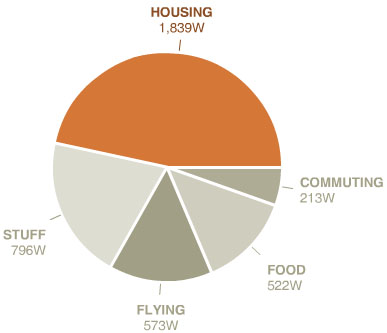
My goal is modest. I’ve like to bring the combined housing and stuff number down by 25% in twelve months. Not sure if that’s possible with the three kids, but they do like the idea of real-time feedback for their actions (rather than, say, a parent praising them merely for turning off the lights in their rooms).
In the end, beyond the sheer nerd factor of monitoring your own energy, what good is it if you don’t use the new information to effect change?
How to enjoy a night in the wilderness, in 7 easy steps
(1) Create a packing list
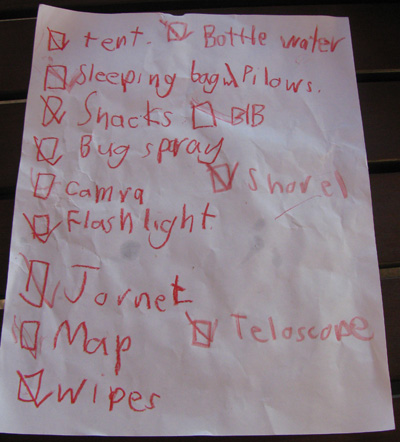
(2) Pick a scenic spot

(3) Set up tent before nightfall (and hope the waters don’t rise)

(4) Listen to the nighttime bestiary come alive and supplement with scary stories

(5) Lay down, look up, and let your handheld astronomy app tell you what you’re observing
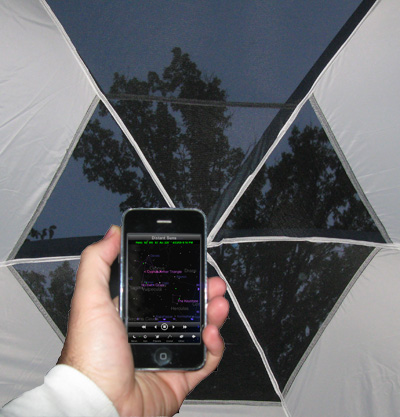
(6) Sleep well, wake up in the mist

(7) Celebrate!
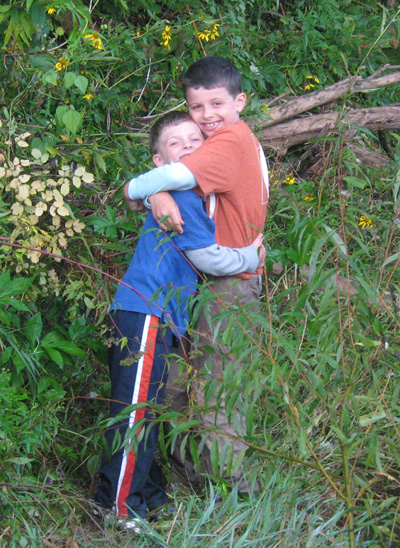
The city is a platform
But it needs your vote.
In what is becoming an annual ritual here, I’d like to ask for the support of Ascent Stage readers in nominating my panel for inclusion at this year’s South by Southwest Interactive conference/fest-a-go-go next year.
Here’s the quick version.
Cities abound in data generated by their inhabitants (virtual worlds, city websites) and created automatically by systems or monitoring. How does this online manifestation of the city interact in tangible ways with urban design and informal urban constructs? Is there such a thing as “the street as platform”?
I have a bunch of panelists in mind, including Andrew Huff of Gapers Block, Dan O’Neill from Everyblock (today of MSNBC!), and some urban design peeps, but we’ll wait to finalize if we get accepted.
The panel-picking site is live and if you’d just scoot over to it, weigh the merits of it against all the other nominees, forget about my past indiscretions and any slights I’ve made against you and your family, then vote for it that’d be great.
Wait, you say you already voted for this a year ago? Well, you may have and if you did, thank you, because this panel was submitted last year — and it was accepted! But so was another proposal I sent in and the organizers deemed the other one better. (I disagreed, thought it turned out OK.) So, if you wouldn’t mind, let’s try to go two for two.
And yes, folks, this is the first hint I’ve dropped on this blog about the newest project I’m working on. More soon!
Put a fork in it
A phenomenal weekend that began with beermakin’ and a crawfish boil concluded today with the merger of several of my favorite things: an outing with my wife (my birthday gift from her) on bike through the neighborhoods of Chicago in search of unique home-grown food fare.
We were part of the new Fork and the Road culinary bike tour of Unsung Chicago Classics. Our group was 13 with two knowledgeable, friendly guides and, though the weather was chafetastically hot, it was a splendid time.
First stop after departing the Loop was Maxwell Street Market and a “brunch” of huaraches, pineapple (!) tamales, and tacos al pastor, including a wonderful taco of beef tongue.

From Market Street we headed just up and over to Greektown to savor lamb and saganaki at The Parthenon where, we were told, the traditional of lighting it on fire, dousing it with lemon juice, and yelling “opaa!” originated. The Parthenon apparently is one of the few Greek restaurants that still builds their gyro cones on the vertical spit in-house. Tasty and ambient (and worth it for the air conditioning), but the best part was yet to come.

We zagged and zigged through the West Loop to Humboldt Park to our final stop at Borinquen Restaurant, originator of the Jibarito “sandwich”. The Jibarito was the best discovery of the trip: steak, lettuce, tomato, and garlic mayo smooshed between plantains. Total delight.

The group was headed back to the Loop whence we began, but thelovelywife and I were so close to home we peeled off. Not a minute after heading out we heard the chimes of an ice cream truck and, given that it was nearly 100° out, we stopped for dessert.
Nearly home, biking up Western, I heard a nasty thwack!, looked back, and found a screw had pierced my tire and exited the other side. We walked the final mile home, sweaty and full.
It’s simply a great thing, exploring the city by bike while indulging in its unique foods, but note even on a hot day and with several miles of pedaling the experience is still, as we were told, “calorie positive”. And absolutely worth it.
Full photoset here.
Kid in a treehouse
This past weekend was our annual neighborhood party, Retro on Roscoe. It’s a all-out fest that ignites the blocks around it for 48 hours. As such, some friends of ours host an annual pre-party that spans all five of their contiguous backyards — something you don’t often see in the city.
I was asked to DJ the party whose theme this year was “Boogie Nights”, basically 70’s tunes infused with other tracks that carry forward the ethos from that era. The booth was a treehouse smack in the middle of the party which we outfitted tip-to-tail with music and lighting gear. I played from 8pm to 3am and, though I almost wet myself (with no backup until late), it was an astounding event.
I had a stripped-down setup (compared to, say, Christmas Party), but it was ample. Just the Macbook Pro running Ableton Live, a Native Instruments Audio Kontrol multichannel interface, and an Akai APC40 control surface. The Akai was perfect, a monome-esque grid with the knobs and sliders of a Novation SL Remote — though far sturdier.
I had hundreds of song fragments pre-loaded and warped — something that gave me almost unlimited flexibility to respond to the crowd without letting things drop. I even entertained requests from those brave enough to scale the nearly vertical steps.
I didn’t want to come down. Why? Let’s recap. I was in a kickass treehouse with another geek (Tom, on lights), a good friend, and a cooler of beer. We were controlling several hundred watts of music and commanding the best view of the space. Sure, we were one chain link’s failure away from death by falling steel, but if that’s how I was supposed to go, I wouldn’t complain.
A few have asked for a recording from the night. I’m still cleaning up most of it, but here’s an excerpt from when I think the most people were out in the yard dancing. (Specifically the slightly sped-up Diana Ross with a few claps and bloops layered on top was the pinnacle, if memory serves.)
[Download the DJ set. Full photoset here.
PS – I’m two-for-two luring Chicago’s finest with low frequencies. I suppose next Christmas we’ll go for the hat trick.
Geeks with a project
If you spend any time on the web you know that today is the 40th anniversary of Apollo 11’s moon landing and the first steps of humans on the lunar surface. There’s been some great coverage from We Choose The Moon, to the live Twitter feed “replay”, to Kottke’s (now-finished) real-time TV coverage playback, to the Google graphic that actually has changed to follow the progression of the landing (and earthrise)!
The commemoration has caused me to reflect personally on the impact of the moon landing. Despite what you may have heard, the name of this blog references the upper half of the lunar lander, the stage that ascends to rendezvous with the command module for the journey home. My choice of that term came from a period of my life of intense interest in spaceflight* partially because of the sheer thrill of it, partially because of the series From The Earth To The Moon, but mostly because, at the time, I was a young project manager in a massive organization who saw in the moonshots the attempt to do something amazing with lots of smart people, cutting-edge technology, and a common goal. I didn’t want to be Neil Armstrong so much as Gene Kranz.
In the tributes, you’re not hearing a lot about the thousands of private contractors who helped plop the 12 guys on the moon. But the organization of that many people to do something of that magnitude in just a little more than 7 years may be as remarkable as the outcome.
IBM, the company that I work for, was a large part of this effort and I admit that this is a source of pride for me. I’ve had this photo of mission control taped to my cube for as long as I can remember.
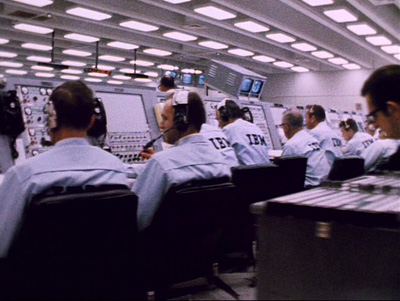
These are my people. Practitioners of a timeless nerdiness that I think of often when I confront organizational bureaucracy or technical hurdles in my own job — one which ain’t, after all, rocket science. IBM has a great subsite up on our contribution to the space race.
Closer to home, I have the memory of my wife’s grandfather, William Boulet, who went to work as an engineer for Boeing after leaving the Army Air Corps after WWII (where he survived a year as a Nazi prisoner). At Boeing Grandpa Boulet designed a particular bolt that was used inside the fuselage of the Saturn V rocket and for his service he was given a commemorative medal — a keepsake I was given by his family when he passed away in 2005. I grabbed it before I left for work today. Not exactly sure why, but I felt like having it with me.
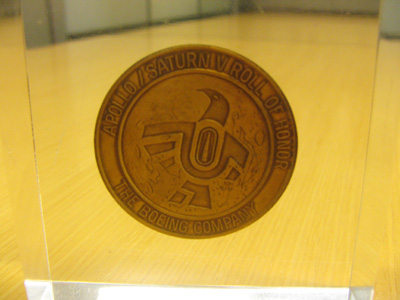
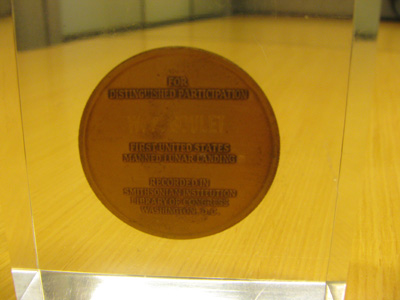
It isn’t nostalgia, of course, for I was not alive for any but the very last landing — and only a newborn then. For me, the Apollo program is equal parts inspirational and aspirational. Whether you agree with the purely political motives that set us on the course to the moon or not, my feeling is that what the effort itself represents is the very best of what humans can do when given a massive challenge packaged in a disheveled box of constraint.
We certainly have freighters full of that particular parcel today. Let’s get unwrapping.
* An interest, it should be noted, that has not so much waned as been tempered by the seeming lack of grand purpose that NASA has fallen into as an orbital trucking company.
Looking into the past
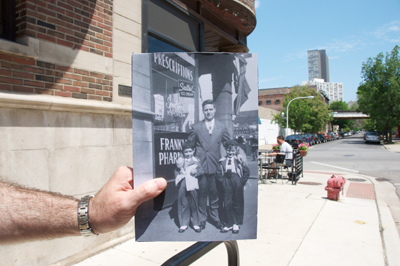
Left-to-right: my father, grandfather, and uncle
Dakin and Sheridan in Lakeview, Chicago. May 29, 2009, some fifty years after the inset photo was taken. (Larger versions available here.)
This location is a few houses down from where my father grew up. To the west (behind the photographer) Dakin dead-ends into the Hebrew Cemetary. Straight ahead is the CTA Red Line at the Sheridan stop. Three blocks to the south (right of the photographer) is Wrigley Field. A childhood paradise!
This particular corner has housed a pharmacy, a porn shop, a coffee house, and a taqueria, among other things.
There’s a lot more of this now-and-then style photography in the Looking into the Past Flickr pool.
Thanks to Chris Gansen for a fun midday diversion.
Meedan

So there’s this project I’ve been working on for years which I’ve been (mostly) mum about.
No more. Now’s the time for talking — across borders, between languages, outside of our disconnected ecosystems of news-gathering.
Welcome to Meedan.
Meedan is a space for conversation and networking — the word ‘meedan’ (ميدان) means ‘town square’ or ‘gathering place’ in Arabic — where everything posted is mirrored between English and Arabic using a mix of human and machine translation.
The project is based on the simple (even self-evident) premise: it’s easy to distrust and misconstrue someone you can’t have a one-on-one conversation with. While the web is a place of massive social interaction, this interaction is almost universally bounded within language groups — a startling barrier to true understanding.
Meedan focuses on reducing this barrier by enabling English and Arabic speakers to
- share news and opinion from the English-language and Arabic-language web
- join cross-language conversations about technology, arts, business and politics
- widen their social network with people who speak a different language and who partake of very different cultures
- write, vet and edit translations in collaboration with users around the world
The project is led by the Meedan organization, a non-profit in San Francisco, with technical development and translation technologies from IBM. Here’s a video introducing Meedan.
So, how does it work?
Comments are instantly translated into Arabic or English using IBM’s machine translation. But because machine translation is not perfect (especially with a language as complex as Arabic) community translators are allowed to edit the translation.
This ability to improve the translations works like editing a Wikipedia article and, in my opinion, is the really novel use of social media on Meedan. (The plan is to allow translations to be rated such that, over time, the best translators emerge as part of a social network of trusted bilingual users.) As a final step, professional translators vet the community-submitted edits. Here’s a video demonstrating comment translation.
These hybrid machine-human translations are then fed back into the system which learns from the ever-growing, vetted corpus. The more people talk, the smarter the machine translation becomes.
Can the system be gamed? Sure. Will there still be misunderstanding, enmity, and deliberate mischievousness? Likely. You can’t change human nature. What Meedan does is provide tools for mitigating the less salutary effects of long-distance, networked conversation between peoples of different cultures.
That’s the hope, anyway. Meedan is in an open (though relatively quiet) beta phase right now. Come on in.
Update: You can get updates via Meedan on Twitter or at their blog.
Everything I need to know about people management I learned from M
A while back I was editing my annual business goals, the benchmark against which I am evaluated at the end of the year. Coincidentally my wife and I and some friends were also watching the latest Bond flick, Quantum of Solace.
Turns out there is a ton of great management advice sprinkled in between the car chases, gun fights, and general tuxedo-style bad-assery. Nearly all of these are said by Judi Dench’s icy Q M*.

How to tell someone that they may be laid off
“I need to know that I can trust you.”
How to give someone the appearance of a last chance even though in your mind you’ve already laid them off
“I need to know you’re on the team. I need to know you value your career.”
How to answer a phone with confidence
“What is it?”
How to delegate
When asked for something have an assistant say on your behalf “Not in the mood.”
How to motivate
“Impress me.”
How to deal with competitors
Ask “Is he one of ours?” If he is not, say “Then he shouldn’t be looking at me.”
How to compliment a colleague
“There is something horribly efficient about you.”
How to deal with government “regulation”
“I don’t give a shit about the CIA.”
How to deal with an over-eager assistant
“[I need] nothing, go away.”
How to end a conversation
Calmly interject “Quiet,” then walk away.
* Update: Wasn’t minding my P’s and Q’s and got M’s code name wrong in the original of this post. Sorry, Bond nerds!



